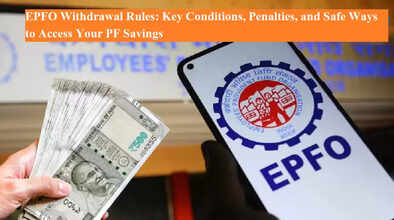EPFO Withdrawal Rules: Key Conditions, Penalties, and Safe Ways to Access Your PF Savings

The Employees’ Provident Fund (EPF) is designed as a long-term savings plan to secure financial stability after retirement. While the Employees’ Provident Fund Organisation (EPFO) allows partial withdrawals under specific circumstances, subscribers must follow strict rules to avoid penalties. Recent reminders from EPFO highlight that misuse of withdrawn funds can lead to serious consequences, including recovery of the amount with interest and a temporary ban on future withdrawals.
When Partial Withdrawals Are Allowed
Under the EPF Scheme, 1952, members can withdraw a portion of their accumulated savings only in limited situations. These include higher education expenses, marriage of self or dependents, medical treatment of serious illnesses, construction or purchase of a house, or repayment of a home loan. Any withdrawal outside these approved purposes is considered unauthorised. EPFO stresses that the fund’s primary goal is to provide financial security after retirement, which is why the rules are intentionally restrictive.
Full Withdrawal Rules
The entire EPF balance is generally available only at the time of retirement. However, a member who remains unemployed for more than two consecutive months can withdraw the full amount after completing a mandatory two-month waiting period. It is important to note that if the withdrawal occurs before completing five years of continuous service, the amount becomes taxable.
Penalties for Misuse of Funds
EPFO has clarified that if a subscriber withdraws money for an approved reason but uses it for another purpose, this will be treated as misuse. In such cases, EPFO can recover the entire amount with applicable interest and may impose additional penalties. For example, if an employee withdraws funds citing house construction but spends it on personal expenses, EPFO can demand repayment and bar the subscriber from making further withdrawals for up to three years. Once the misused amount is repaid with interest, the restriction may be lifted.
Why Strict Rules Exist
Financial experts explain that provident fund savings are meant to safeguard a person’s post-retirement life. Premature withdrawals, especially for non-essential purposes, can deplete the retirement corpus and create financial hardship in later years. The strict withdrawal conditions are therefore designed to discourage unnecessary use of the fund and to preserve its long-term benefits.
Key Takeaways for Subscribers
-
Know the Allowed Purposes: Only withdraw for marriage, higher education, serious illness, or housing-related needs.
-
Maintain Proper Documentation: Ensure that all claims are supported by valid proof to avoid disputes or penalties.
-
Understand the Tax Rules: Withdrawals before five years of service can attract income tax.
-
Avoid Misuse: Using funds for unapproved reasons can lead to recovery of the amount with interest and a ban on future withdrawals.
The EPF remains one of the most reliable retirement savings tools in India, offering both safety and tax benefits. Subscribers should treat it as a long-term financial cushion and avoid premature withdrawals unless absolutely necessary. By following EPFO’s guidelines carefully, members can protect their hard-earned savings and ensure a secure financial future after retirement.

